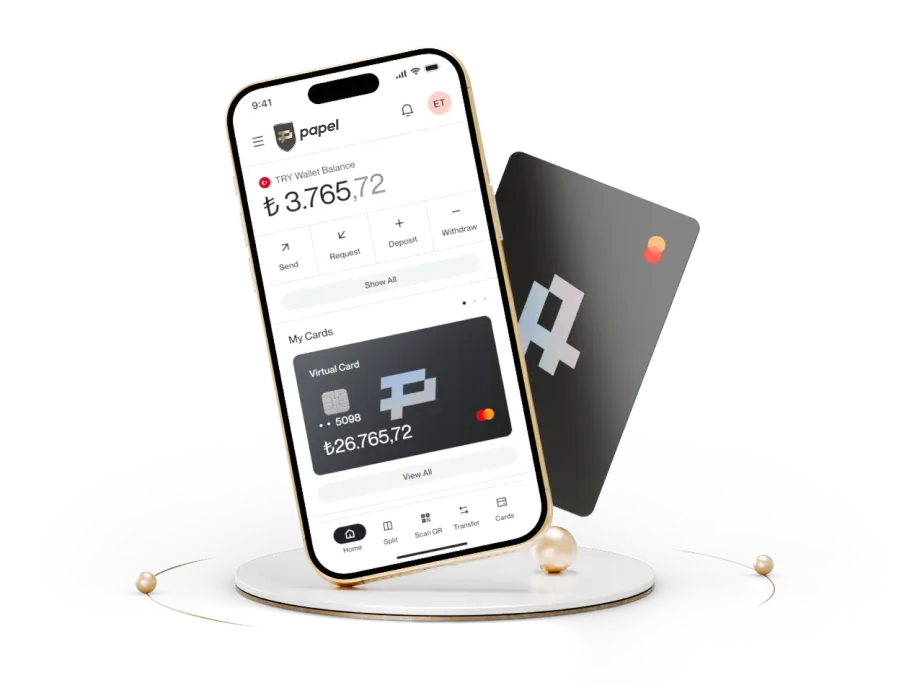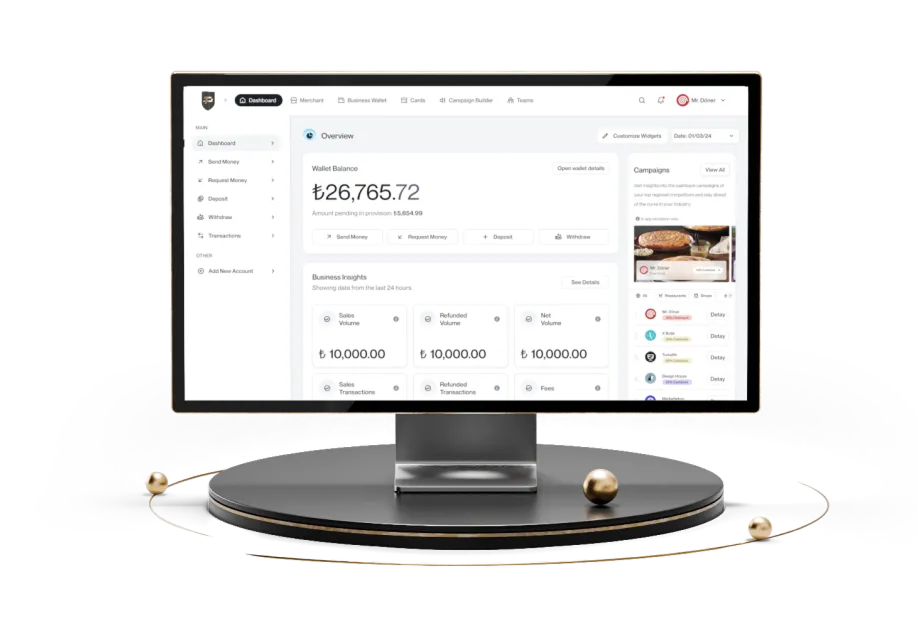Akıllı Cihazlarla Finansal Hayatını Kolaylaştırman Mümkün: Giyilebilir Bankacılıkla İlgili Bilmen Gerekenler
Giyilebilir teknolojilerin kullanımının yaygınlaşmasıyla beraber 'Giyilebilir Bankacılık' da günlük finansal deneyimimizi farklı bir boyuta taşıyor. Günümüzde akıllı saatler başta olmak üzere giyilebilir cihazlarla temassız ödeme, para transferi gibi günlük finansal işlemler kolaylıkla yapılabiliyor. Giyilebilir bankacılık gelecekte ise her an erişilebilir bir finansal deneyim vadediyor.
Giyilebilir Teknoloji Nedir?
Giyilebilir teknoloji, günlük yaşamı kolaylaştırmak için tasarlanmış teknolojilerdir. Bu cihazlar, sağlık verilerini izlemek, iletişim ya da eğlence amacıyla tasarlanmıştır. Akıllı saatler, sanal gerçeklik gözlükleri ve akıllı giysiler bu cihazlara örnek olarak gösterilebilir. Sensörler ve bağlantı teknolojileri kullanarak telefon gibi diğer cihazlarla senkronize olarak çalışabilir, bildirimler alabilir, kalp atışı ve uyku düzeni gibi sağlık verilerini takip edebilirler. Son zamanlarda ise teknolojinin gelişmesiyle beraber, gündemde olan temassız finansal işlemleri giyilebilir cihazlarla gerçekleştirmek mümkün hale geldi.
Giyilebilir Bankacılık Nedir?
Giyilebilir teknolojik cihazlar aracılığıyla bankacılık hizmetlerine erişim sağlanması anlamına gelen giyilebilir bankacılık teknolojisi; akıllı saatler, bileklikler veya gözlükler gibi cihazlarla finansal işlemler gerçekleştirilebilmesini sağlar. Mobil bankacılık uygulamalarına bağlanarak para transferleri ya da ödeme işlemleri gerçekleştirebilen bu cihazlar, finansal işlemleri daha hızlı ve kolay hale getirerek kullanıcı deneyimini geliştirir. Bu teknoloji özellikle temassız ödeme sistemleriyle beraber yaygınlaşmıştır. Giyilebilir cihazlarda bulunan NFC (Yakın Alan İletişimi) teknolojisi sayesinde, fiziksel bir kart gereği olmadan hızlı ve güvenli bir şekilde ödeme yapmak mümkün. Çoğunlukla akıllı saatler olmak üzere bluetooth kulaklıklar, sanal gerçeklik gözlükleri gibi giyilebilir teknolojik cihazların sadece 2021 yılında yaklaşık 500 milyon adet satıldığını göz önüne alırsak, giyilebilir teknolojilerin ve beraberinde giyilebilir bankacılık uygulamalarının büyük talep gördüğünü söylemek yanlış olmaz.

Giyilebilir Bankacılığın Geçmişi
Gelişimi devam eden ve gelecekte daha da yaygınlaşacağı düşünülen giyilebilir bankacılık teknolojilerinin geçmişini 2000’li yıllara kadar uzatmak mümkün. 2000’li yılların başında ortaya çıkan mobil bankacılık, internete bağlanan cep telefonları ve sonrasında akıllı telefonlarla, bankacılık hizmetlerinin taşınabilir hale gelmesini sağladı. Mobil cihazlar için uygulamaların gelişmeye başlaması ve akıllı telefonların yaygınlaşmasıyla beraber giyilebilir cihazlar için bir temel oluşmuş oldu. Akıllı saatlerin ve fitness takip cihazlarının 2010’ların başında popülerleşmesinin ardından bankalar ve teknoloji şirketleri bu cihazlar üzerinden ödeme ve bankacılık işlemlerinin yapılabilmesini nasıl mümkün hale getirebileceklerini araştırmaya başladı. Bunun sonucunda gelişen NFC (yakın alan iletişimi) teknolojisi, temassız ödeme sistemlerinin yaygınlaşmasına öncülük etti. Giyilebilir bankacılık adına atılan ilk somut adımlar ise bankaların giyilebilir cihazlara özel uygulamalar geliştirmesiyle atıldı. 2015 yılında Apple Pay ve Google Pay gibi mobil ödeme sistemlerinin devreye girmesi akıllı saat ve diğer giyilebilir cihazlarla ödeme yapılmasının yolunu açtı. 2015 ve sonrasında ise giyilebilir cihazların ödeme sistemlerine entegrasyonu hız kazandı ve NFC teknolojisinin de gelişmesiyle beraber temassız ödeme giderek yaygınlaştı. Mastercard ve Visa gibi büyük finansal kuruluşlar, giyilebilir bankacılık uygulamalarını desteklemeye başladı. Bu sayede kullanıcılar, banka kartlarını dijital olarak giyilebilir cihazlarına entegre ederek fiziksel kart gerekliliğini ortadan kaldırdı ve alışveriş deneyimlerini değiştirdiler.
Giyilebilir Bankacılığın Sunduğu Avantajlar
Giyilebilir cihazlar, bankacılık işlemlerinin çok daha pratik ve kolay bir şekilde gerçekleştirilebilmesini sağlar. Giyilebilir bankacılığın faydalarını şu şekilde sıralayabiliriz:
- Kolay ve hızlı erişim
- Temassız ve güvenli ödeme
- Zaman ve verimlilik kazancı
- Kişisel finans yönetimi
- Güvenlik ve acil durum yönetimi
- Geleceğe uygunluk ve inovasyon
Kolay ve hızlı erişim
Giyilebilir cihazlar, kullanıcıların banka hesaplarına anında erişebilmesine olanak tanır. Para transferi, bakiye kontrolü ve işlem geçmişini görüntüleme gibi birçok işlem birkaç tıklamayla anında yapılabilir. Bununla beraber anlık bildirimler sayesinde harcama, para çekme ya da para transferleriyle ilgili eş zamanlı olarak bilgi almak mümkün olur. Bu da kişilerin finansal durumlarının takibini gerçekleştirmesini kolaylaştırır.
Temassız ve güvenli ödeme
NFC teknolojisi sayesinde fiziksel bir karta ihtiyaç olmadan giyilebilir cihazlarla ödeme yapabilmek mümkündür. Aynı zamanda bu cihazlar biyometrik doğrulama ve şifreleme gibi güvenlik özelliklerine de sahip olduğundan ödeme ve bankacılık işlemleri güvenlik standartlarına uygun bir şekilde gerçekleştirilebilir.
Zaman ve verimlilik kazancı
Finansal işlemler için ATM’ye gitmek ya da telefondan uygulama açmaya gerek kalmadan giyilebilir cihazlarla işlem yapabiliyor olmak işlemleri hızlandırarak zaman kazandırır. Giyilebilir cihazlar sayesinde fiziksel kart ya da cüzdan taşıma gereği olmadan finansal işlemler gerçekleştirilebildiğinden hareket halindeyken ya da seyahat sırasında kişilere büyük kolaylık sağlar.
Kişisel finans yönetimi
Giyilebilir bankacılık uygulamaları kullanıcılara anlık bildirimler ve raporlar ileterek kişisel finans yönetimini kolaylaştırır. Kullanıcılar, giyilebilir cihazlardan bütçe ayarlarını yapabilir, harcamalarını limitleyebilir ve harcama alışkanlıklarını düzenli olarak takip edebilirler.
Güvenlik ve acil durum yönetimi
Giyilebilir cihazlara anında gelen bildirimler sayesinde şüpheli işlem ya da hesap hareketi gerçekleşirse hemen haberdar olunacağı için dolandırıcılık ve hırsızlık gibi durumlar daha hızlı bir şekilde fark edilebilir, bu sayede hesap güvenliği sağlanmış olur. Ayrıca giyilebilir cihazlar sayesinde bankacılık işlemleri dijital olarak gerçekleşebildiğinden cüzdan ya da fiziksel kart ihtiyacı olmaz. Cüzdan ya da para taşınmaması da olası hırsızlık durumlarının önüne geçilebilmesini sağlar. Giyilebilir bankacılık kullanıcıların acil durumlarda banka hesaplarına hızla erişerek ödeme yapabilmesini de sağlayarak kişilere zor durumlarda destek sağlar.
Geleceğe uygunluk ve inovasyon
Giyilebilir bankacılık uygulamaları yapay zeka, sesli komutlar ve biyometrik doğrulama gibi ileri teknolojilerle entegre olarak kullanıcı deneyimini geliştirir. Gelecekte daha yenilikçi ve kullanıcı dostu çözümlerin de bu sayede ortaya çıkmasını beklemek hiç yanlış olmaz.
Giyilebilir Bankacılıkta Güvenlik Nasıl Sağlanır?
Kullanıcıların giyilebilir cihazlarla bankacılık işlemlerini güvenli bir şekilde yapmalarını sağlamak için çeşitli teknolojiler ve yöntemler kullanılır. Bankaların ve teknoloji sağlayıcılarının, giyilebilir cihazların kullanıcı verilerini ve işlemlerini koruyabilmek adına uyguladığı güvenlik önlemlerinden bazıları şunlardır:
- NFC ve temassız ödeme güvenliği
- Biyometrik doğrulama
- Dolandırıcılık izleme ve anormal aktivite tespiti
- Cihaz kilidi ve uzaktan silme
- Veri şifreleme
- İki aşamalı kimlik doğrulama (2FA)
NFC ve temassız ödeme güvenliği
Giyilebilir bankacılıkta temassız ödeme yapabilmek için kullanılan NFC teknolojisi kısa mesafeden çalıştığı için izinsiz erişim ya da kopyalama işlemlerinin önüne geçer. Bununla beraber temassız ödemelerde genellikle harcama limiti bulunur, bu da cihazın kaybı gibi bir durumda yüksek miktarda para çekilmesine engel olur.
Biyometrik doğrulama
Giyilebilir cihazlar, kullanıcı kimliğini doğrulamak için parmak izi tarama ya da yüz tanıma gibi sistemleri kullanırlar. Bu biyometrik veriler sadece cihaz sahibi işlem yapabilmesine olanak sağlar.
Dolandırıcılık izleme ve anormal aktivite tespiti
Giyilebilir bankacılık kullanımında anormal bir durumun tespit edilmesi söz konusu olduğunda cihaza anında bildirim geleceğinden kullanıcılar yetkisiz işlemlerden hızlıca haberdar olarak gerekli önlemleri alabilir. Bununla beraber bankalar, anormal aktivite tespiti yapabilmek için yapay zeka algoritmalarından yararlanır. Bu yapay zeka kullanan sistemler, kullanıcıların bankacılık alışkanlıklarını analiz ederek olağanın dışında bir işlem olması durumunda uyarıda bulunur.
Cihaz kilidi ve uzaktan silme
Giyilebilir cihazlar belli bir süre kullanılmazsa otomatik olarak kilitlendikleri için kullanıcıların tekrar erişebilmesi için pin ya da biyometrik doğrulama kullanması gerekir. Bu sebeple cihazın çalınması ya da kaybolması gibi durumlarda cihaza yetkisiz erişim sağlanamaz. Ayrıca, böyle bir durumda cihazın uzaktan devre dışı bırakılması ya da içerisindeki verilerin silinmesi de mümkün olduğundan herhangi bir güvenlik riski olmadan cihaz etkisiz hale getirilebilir.
Veri şifreleme
İnternet bağlantılarının güvenliği için SSL/TLS protokolleri kullanılır, bu sayede internet üzerinden yapılan bankacılık işlemleri korunur. Bununla beraber, giyilebilir bankacılık işlemleri sırasında cihaz ile banka arasındaki verilerin izinsiz bir şekilde başka kişiler tarafından görülmesini engellemek için uçtan uca şifreleme koruması kullanılır. Bu şekilde giyilebilir cihazlarla ödeme veya para transferi yapılırken veriler şifrelenerek güvenli bir şekilde iletilir.
İki aşamalı kimlik doğrulama (2FA)
Bankacılık uygulamalarında olduğu gibi giyilebilir bankacılık uygulamalarında da kullanılan iki aşamalı doğrulama işlem sırasında güvenliği artırır. Kullanıcıların cihazda işlem yapmadan önce erişim sağlayabilmek için telefonuna ya da e-posta adresine gelen bir kodu onaylamasının gerekmesi güvenliği yüksek oranda artırır.

IoT (Internet of Thing - Şeylerin İnterneti) Nedir?
Nesnelerin interneti anlamına gelen IoT teknolojisi günlük hayatta kullanılan cihazların ve sistemlerin birbirlerine internet yoluyla bağlanmasını sağlayarak veri toplama, paylaşma ve işleme yeteneğine sahip bir ekosistemdir. Cihazlar sensörlerle veri toplar ve topladığı verileri bağlantılar yoluyla iletir, bulut sistemlerine işler ve kullanıcı arayüzleriyle yönetilir. IoT akıllı evlerden, sağlık, tarım, endüstriyel sistemler ve otonom araçlara kadar birçok farklı alanda kullanılmaktadır. Kullanıcı deneyimini geliştirmeyi amaçlayan IoT giyilebilir cihazların birbirleriyle ve çevrelerindeki diğer cihazlarla internet yoluyla veri alışverişi yapmasını sağlar ve bu sayede giyilebilir bankacılık sistemlerini daha akıllı ve bağlantılı hale getirir. IoT teknolojisi sayesinde giyilebilir cihazlar üzerinden gerçekleştirilen bankacılık işlemleri daha güvenli, hızlı ve kullanıcı dostu bir şekilde gerçekleşebilir.
Giyilebilir Bankacılığın Geleceğinde Neler Olacak?
Giyilebilir bankacılık teknolojisi gelecekte finans dünyasında birçok yenilik ve gelişmiş hizmet sunmayı vaat ediyor. Kullanıcıların akıllı saatler, gözlükler ve diğer giyilebilir cihazlar aracılığıyla daha hızlı ve güvenli bir şekilde finansal işlemlerini gerçekleştirebilmesinin yanı sıra IoT teknolojisinin ve 5G altyapısının da gelişmesiyle beraber çok daha fazla cihazın birbirlerine bağlı olacak. Böyle bir gelecekte kullanıcılar bankacılık işlemleri için değil bütün finansal işlemlerini sorunsuz bir şekilde yapabilecek. Bu cihazlar, bağlı oldukları bütün nesnelerle entegre çalışacaklar ve diğer cihazlardan aldıkları verileri yapay zeka teknolojisiyle beraber analiz ederek kişisel hale gelecekler. Bu da yapay zeka destekli akıllı asistanların kullanıcının harcama alışkanlıkları gibi finansal verilerini analiz ederek kişiye özel öneriler ve bildirimler vereceği ve bu şekilde kişilerin finansal durumlarını daha kolay bir şekilde yönetebileceği anlamına geliyor. Güvenliğin en üst seviyede olacağı giyilebilir bankacılığın geleceğinde biyometrik verilerin kullanımı artacak ve herhangi bir şifre ihtiyacı olmadan biyometrik veriler sayesinde finansal işlemler daha hızlı ve kolay gerçekleşebilecek. Biyometrik güvenliğin gelişmesi güvenlik açıklarını kapatarak dolandırıcılık ihtimalini minimuma indirecek. Bununla beraber akıllı gözlüklerle entegre AR (artırılmış gerçeklik) teknolojisi sayesinde finansal işlemleri gerçekleştirmek için kullanıcıların sesli olarak komut vermesi ve göz hareketleri yeterli olacak.
Kişilerin sağlık durumlarını da takip eden giyilebilir cihazlar gelecekte bankacılık sistemleriyle entegre olarak kullanıcıların sağlık durumlarına göre finansal tavsiyeler verecek. Örneğin, kişinin sağlık durumuna veya stres seviyesine göre aldığı finansal kararların doğruluğunu sorgulayacak. Ya da kullanıcının sağlık harcamalarını takip ederek önerilerde bulunacak. Teknolojinin gelişimiyle beraber günümüzde Güney Kore’de örneğine rastladığımız akıllı şehir projelerinin ülkemize entegre olmasıyla beraber giyilebilir teknolojinin kullanımı daha geniş bir ekosisteme yayılacak. Böylece giyilebilir bankacılık sistemleri akıllı şehir altyapısından topladığı verilerden yola çıkarak kişinin harcama alışkanlıklarını optimize edebilecek.
Sıkça Sorulan Sorular
- Giyilebilir bankacılığın sunduğu avantajlar nelerdir?
Giyilebilir bankacılık sistemleri kişilere temassız ve güvenli ödeme, zaman tasarrufu, kolay ve hızlı erişim, kişisel finans yönetimi gibi avantajlar sağlar. Bu sayede bankacılık işlemlerinden alınan verim de artmış olur.
- Giyilebilir bankacılıkta güvenlik nasıl sağlanır?
Giyilebilir bankacılık sistemleri NFC, biyometrik doğrulama, veri şifreleme, iki aşamalı kimlik doğrulama, cihaz kilidi ve dolandırıcılık izleme gibi yöntemler ve teknolojilerle güvenlik sağlar.
- NFC nedir?
NFC, iki cihazın fiziksel olarak birbirlerine 4 cm ya da daha yakın bir mesafeden iletişim kurabilmesini sağlayan bir teknolojidir. Bu teknoloji temassız ödemelerin hızlı ve kolay bir şekilde gerçekleşmesini sağlar.
- Biyometrik doğrulama nedir?
Biyometrik doğrulama, bir kişinin kimliğini belirlemek ve doğrulamak için fiziksel veya davranışsal özelliklerini kullanan bir güvenlik yöntemidir. Kişilerin kimliklerini parmak izi, iris ve yüz taraması ya da ses tanıma gibi başkasıyla benzemesinin mümkün olmayacağı verileri kullanarak doğrular, bu sayede güvenliği sağlamış olur.

